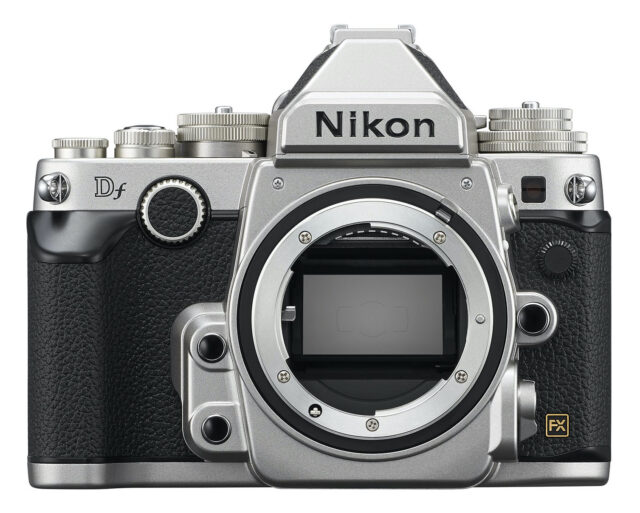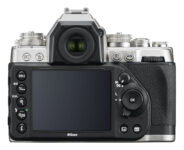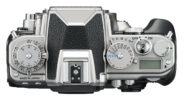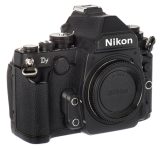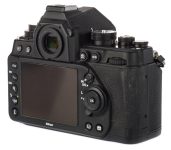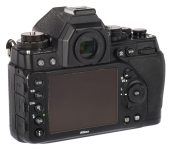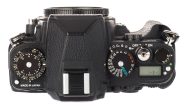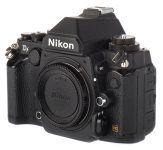Announced
Production status
System
Nikon F system cameras
- Nikkorex F
- Nikkormat EL
- Nikkormat ELW
- Nikkormat FS
- Nikkormat FT
- Nikkormat FT2
- Nikkormat FT3
- Nikkormat FTN
- Nikon D3
- Nikon D3s
- Nikon D3X
- Nikon D4
- Nikon D4s
- Nikon D5
- Nikon D6
- Nikon D600
- Nikon D610
- Nikon D700
- Nikon D750
- Nikon D780
- Nikon D800
- Nikon D800E
- Nikon D810
- Nikon D850
- Nikon Df
- Nikon EL2
- Nikon EM
- Nikon F
- Nikon F100
- Nikon F2
- Nikon F3
- Nikon F4
- Nikon F5
- Nikon F6
- Nikon FA
- Nikon FE
- Nikon FE10
- Nikon FE2
- Nikon FG
- Nikon FG-20
- Nikon FM
- Nikon FM10
- Nikon FM2
- Nikon FM2/T
- Nikon FM3A
- Nikon N2000
- Nikon N2020
- Nikon N4004
- Nikon N4004S
- Nikon N50
- Nikon N5005
- Nikon N55
- Nikon N60
- Nikon N6000
- Nikon N6006
- Nikon N65
- Nikon N70
- Nikon N75
- Nikon N80
- Nikon N8008
- Nikon N8008S
- Nikon N90
- Nikon N90S
Nikon Df
35mm AF digital SLR camera • Discontinued
Specification
| Format: | |
| 35mm full frame | |
Imaging sensor: | 36 × 23.9mm CMOS sensor |
Resolution: | 4928 × 3280 - 16 MP |
Sensor-shift image stabilization: | - |
| Nikon F [46.5mm] | |
| Shutter: | |
Type: | Focal-plane |
Model: | Electronically controlled |
Speeds: | 30 - 1/4000 + B |
| Exposure: | |
Exposure metering: | Through-the-lens (TTL), open-aperture |
Exposure modes: | Programmed Auto |
| Aperture-priority Auto | |
| Shutter-priority Auto | |
| Manual | |
| Physical characteristics: | |
Weight: | 765g |
Dimensions: | 143.5x110x66.5mm |
Manufacturer description
TOKYO - Nikon Corporation is pleased to announce the release of the Df, a Nikon FX-format digital SLR camera.
The Df combines intuitive, worry-free dial operation with superior image quality over a broad range of sensitivities in the smallest and lightest FX-format body, making the camera extremely portable. Large metal mechanical dials on the top of the camera enable direct, intuitive operation, offering tactile pleasure of shooting with precision mechanics, and allowing users to feel the joy of creating images that reflect their individual intent. The camera also provides a system that allows users to focus on shooting with the security that comes from visual confirmation of ISO sensitivity, shutter speed, and exposure compensation values, as well as the convenience of direct adjustment of settings at any time, even when the camera is turned off.
With the same FX-format CMOS sensor, effective pixel count of 16.2-million pixels, and EXPEED 3 image-processing engine as the D4 flagship model, the Df offers stable, superior image quality under a wide variety of lighting conditions. It supports a broad range of standard sensitivities, from ISO 100-12800, with additional reduction to the equivalent of ISO 50 and expansion to the equivalent of ISO 204800 when necessary.
Superior portability and stable D4 image quality over a broad range of ISO sensitivities, from low to high, release users from common restrictions such as time, place, and lighting conditions, thus increasing the range and flexibility of expression.
What's more, the AF-S NIKKOR 50mm f/1.8G(Special Edition) kit lens, which maximizes the portability of the Df, will be released at the same time as the camera. Based on the AF-S NIKKOR 50mm f/1.8G normal lens, which was so well received for its superior optical performance in a compact and lightweight body, this lens was redesigned to serve as the perfect match for the Df. A leather-like texture on the outside surface of the lens, a silver aluminum ring, and a focus ring that reproduces the knurls on manual focus lenses were adopted for the AF-S NIKKOR 50mm f/1.8G(Special Edition). In addition, an optical design utilizing an aspherical lens element enables both sharp rendering and beautiful blur characteristics. This compact, lightweight, and fast fixed focal length lens is perfectly suited to the flexible, nimble photography for which the Df was designed.
Adoption of a collapsible metering coupling lever also enables use of non-AI lenses with the camera. As the Df is equipped with the Nikon F mount, which has not changed since Nikon released its first SLR camera, the combination of older NIKKOR lenses and a camera incorporating the latest digital technologies allows users to enjoy capturing photographs exhibiting a wide variety of forms of expression.
Development background and goals
In recent years, the digital SLR camera market has responded to demands for higher pixel counts, faster operation and performance, and more functions with high-spec cameras that support capture of images as intended with advanced technologies and the ability to respond to a variety of techniques, shooting situations and conditions. The spread of such high-performance digital SLR cameras offer photographers greater convenience in a variety of ways. The Df was developed with a different approach and with an eye on offering different forms of value. Not only does it support the capture of more beautiful and artistic photos, as well as a variety of photographic expression, possible with other cameras, it also allows users to take their time with each individual photo to achieve images they will enjoy, as well as making the process of photography itself more pleasing.
The Df presented by Nikon, which has developed interchangeable-lens cameras and NIKKOR lenses for decades, and also achieved a number of technical innovations, was developed based on the concept of fusing responsive and intuitive operation with the feel of a precision device and D4 image quality in a compact and lightweight body that is extremely portable. This embodiment of a tool that stimulates user creativity and enables the pure enjoyment of photos responds to the needs of photographers looking to capture more creative photos.
Df Primary Features
1. Dial operation that offers tactile pleasure of shooting with precision mechanics, a body design that delights owners, and an advanced optical viewfinder expected of an SLR camera
Simple and intuitive dial operation that stimulates creativity
Application and adjustment of shooting settings is simple and intuitive with the Df, allowing users to capture photos as intended. ISO sensitivity, shutter speed, and exposure compensation are set using dedicated dials*. The camera provides a system that allows users to better focus on shooting with the security that comes from quick visual confirmation of current settings, as well as the convenience of direct adjustment of settings at any time, regardless of whether the camera is turned on or off. Shutter speed can be fine-tuned by setting the shutter-speed dial to "1/3 STEP" and rotating the main command dial.
Precision design that delights owners
Large mechanical dials and a linear form have been adopted to offer tactile pleasure of shooting with precision mechanics. The level of detail applied to all aspects of layout and materials of the Df reminds users of traditional Nikon cameras and lets them fully recognize that digital SLR cameras are precision devices. A magnesium alloy has been adopted for the top, back, and bottom covers on the camera body for solid metal touch, and surfaces such as those of grip finished with an elegant leather-like texture fit the hand comfortably. Each of the metal mechanical dials has been carved, and all indicators on the top of the camera are engraved and painted Fine knurling around dials offers comfortable feel and finger placement, and dials themselves rotate smoothly and "click" into position for a smart, high-precision feel with operation.
An optical viewfinder utilizing a glass pentaprism and offering frame coverage of approximately 100% for clear display of the view through the lens in real-time
The optical viewfinder built into the Df preserves frame coverage of approximately 100% for efficient utilization of the large and bright viewfinder image offered by the FX format and a glass pentaprism. Visual confirmation of the arrangement of all elements within the image area allows users to frame their shots with great precision. Viewfinder magnification of approximately 0.7x* allows users to easily confirm all visual elements, including the viewfinder display. The focusing screen, on which images are clearly formed, enables precise focus confirmation with autofocusing, and also supports the same precise focusing with manual focus. In addition, a camera menu option enables display of a framing grid that makes composing shots that are level horizontally and vertically simple.
2. D4 image quality achieved with an effective pixel count of 16.2-million pixels, FX-format CMOS image sensor and EXPEED 3 image-processing engine
Equipped with the same image sensor and image-processing engine as our D4 flagship model, the Df offers stable, superior image quality under a wide variety of lighting conditions. It supports a broad range of standard sensitivities, from ISO 100-12800, with additional reduction to the equivalent of ISO 50 and expansion to the equivalent of ISO 204800 when necessary. In low-light situations when a tripod cannot be used, the camera utilizes superior high-sensitivity performance for hand-held shooting of images exhibiting sharp rendering of details with very little of the grain caused by noise, and preserving vivid colors. The Df is also able to reproduce textures with a superior three-dimensional appearance at low sensitivities, such as ISO 100, without sacrificing dynamic range. Sharp and clear rendering with crisp edges in images captured in brightly lit situations or those exhibiting great contrast due to a bright light source enables rich expression of tones in both highlights and shadows. With its superior portability and ability to respond to a wide variety of lighting conditions, the Df will expand the flexibility with which users take on their photographic works.
3. A camera that is both strong and the smallest and lightest in the history of Nikon FX-format digital SLR cameras
The Df measures approximately 143.5 x 110.0 x 66.5 mm (W x H x D) and weighs approximately 710 g*, making it the smallest and lightest in the history of Nikon FX-format digital SLR cameras. Adoption of a magnesium alloy for the top, back, and bottom covers on the camera body makes the camera compact and lightweight while preserving strength and durability. All parts of the camera are effectively sealed for a level of dust- and water-resistance equivalent to that of D800-series cameras. The Df is a camera that offers superior mobility with a compact and lightweight size that is extremely portable, excellent basic performance, and a high level of strength and reliability.
4. Excellent basic performance and advanced technologies that support full-scale imaging
The Df offers simple operation and powerful support for capturing photos as intended with excellent basic performance and advanced functions that respond to the demands of photo hobbyists intent on capturing artistic and creative photographs.
Equipped with an AF system offering 39 focus points
The Df is equipped with the Multi-CAM 4800 autofocus sensor module. The densely packed 39 focus points enable certain acquisition and tracking of the intended subject, and adoption of cross-type sensors, which provide further accuracy, for the 9 points most frequently used at the center of the frame offer more precise focus acquisition. 7 of the focus points support f/8, making accurate autofocusing possible even when a telephoto lens with a maximum aperture of f/4 is used with a 2x teleconverter for a combined maximum aperture of f/8.
Scene Recognition System with built-in 2,016-pixel RGB sensor
The Df is equipped with the Scene Recognition System, which analyzes detailed information acquired from the 2,016-pixel RGB sensor and the image sensor regarding aspects such as scene brightness and colors for optimal control over autofocusing, auto-exposure, i-TTL balanced fill-flash, and auto white balance.
Quick, stress-free response
The Df offers superior, high-speed response with a power-up time of approximately 0.14 s*1, a release time lag of roughly 0.052 s*1, and high-speed continuous shooting at approximately 5.5 fps. It also supports SDXC and UHS-I*2 high-speed memory cards, as well as Eye-Fi memory cards that enable simple wireless transfer of images captured with the camera.
An [i] button that enables quick access to frequently used camera functions
The [i] button, positioned to the bottom left of the camera's monitor, enables simple access to convenient functions with viewfinder and live view photography, and image playback. Pressing this button displays options for the desired setting, allowing immediate access to setting options for normal shooting, live view photography, and the retouch menu in playback mode.
A variety of live view functions
In addition to the 16-cell framing grid available with previous models, the Df also offers users the choice of a 9-cell framing grid, or display of the 16 : 9 or 1 : 1 aspect ratio in the camera monitor with live view photography. Further, the virtual horizon displayed in the monitor allows users to verify the direction of both roll (tilt to the left or right) and pitch (tilt forward or back), and a roll indicator can also be displayed in the viewfinder. The spot white balance function enables precise white-balance measurement using a specified object or portion of the frame in the live view display. This eliminates the need to prepare a reference object, such as a gray card, and enables quick acquisition of data for subjects that cannot be approached for application of a preset white-balance value without missing photo opportunities.
Power-saving design that supports worry-free focus on shooting
Adoption of more efficient power supply circuitry and use of EXPEED 3, which consumes little power, minimize the camera's power consumption. When a fully charged compact and lightweight Rechargeable Li-ion Battery EN-EL14a supplied with the camera is used, approximately 1,400* still images can be captured.
5. Use of non-AI NIKKOR lenses
Not only is the Df capable of capturing high-quality images using the latest NIKKOR lenses optimized for digital SLR cameras, it is the first Nikon digital SLR camera equipped with a collapsible metering coupling lever that enables the use of non-AI lenses.
When focal length and maximum aperture value for non-AI lenses are registered with the camera beforehand, optimal exposure can be achieved with exposure metering when the camera aperture setting is matched to the aperture value specified with the aperture ring on the lens by rotating the sub-command dial (supported only in [A] and [M] exposure modes). As the Df is equipped with the Nikon F mount, which has not changed since Nikon released its first SLR camera, the combination of older NIKKOR lenses and a camera incorporating the latest digital technologies allows users to enjoy capturing photographs exhibiting a wide variety of forms of expression.
Special editions (1)
- Nikon Df "Gold Edition" (1600 units) - November 2014
Similar cameras (2)
35mm full frame • Auto focus • Digital • Singe-lens reflex • Nikon F mount
| Model | Shutter | Metering | Modes | Year |
|---|---|---|---|---|
| Kodak DCS Pro 14n | E, 1/4000 | TTL • OA | PASM | 2002 ● |
| Kodak DCS Pro SLR/n | E, 1/4000 | TTL • OA | PASM | 2004 ● |
